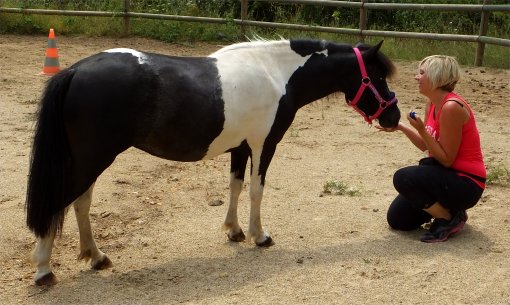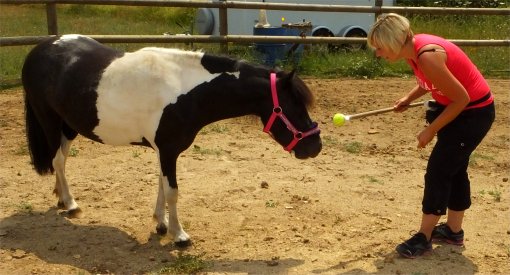General Articles
Clicker Training with Didi and Unique
The clicker is a very effective training tool and can be used to train not only dogs but a wide variety of animals including horses.
For more information on Clicker Training, please refer to my clicker training video on the following link:
www.therivierawoman.com/?action=show&id=1123
When introducing the clicker to a horse we do this in exactly the same way as with any other animal.
First of all we need to pick the perfect reinforcement which in this case is some tasty morsels of carrot and apple.

Once kitted out with Bumbag and treats and I started to work with Didi the horse and Unique the pony.
It is always a good idea to initially work with your horse when introducing the clicker, through a fence or stable door. The reason being, that often the horse can be very keen to get the treats and can be a little overexcited. Working through a fence for example in a horse ménage, enables you to have distance from the horse which allows you to keep good timing between clicking and treating as the horse starts to make an association between the clicker and reinforcement.
In addition if the horse does become a little over-exuberant with the treats, you can back away from the horse easily therefore not reinforcing this behaviour whilst showing the horse what type of behaviour they need to display in order to receive clicks and treats. Essentially it just allows for a more controlled and a successful training session.

Didi the horse
When conducting my training session with Didi and Unique I worked with them separately. Firstly training Didi through the ménage fence and then with Unique I worked directly with her in the ménage as she was less excited and also was a little calmer when given the treats than Didi was initially.

Unique the pony
The session in both cases started with conditioning ‘’the meaning of the clicker’’ and this meant introducing the sound of the clicker followed by a treat and plenty of praise and this was done several times so Didi and Unique started to recognise the sound of the clicker. Very soon both Didi and Unique started to understand that the clicker meant the provision of reinforcement (treats and praise).
Once they started to understand the association between click and treat, I started to apply the clicker so I could start to target train them.
A target is typically a stick with a ball on the end but anything really can be used to target train as long as it is the correct size and the animal you are training is able to perceive it. Your fist or a flat hand can be used, as well as a training cone for example or food lid etc.
When we target train we are training the animal to place their nose on a target stick on command and once target trained we can train an animal to carry out many more complex behaviours such as walking in and around objects (slalom) and much more. When training the horse to slalom we can get them to follow the target stick and eventually we can add in commands and maybe a hand signal so that the target stick is no longer required.

The target stick can also be used to train veterinary behaviours for example the animal can be trained to hold their nose on the target whilst a veterinary examination is carried out.
Very soon both Didi and Unique started to understand what they needed to do and very quickly started to touch their nose onto the target stick.

I first started placing the target near to them so they may accidently touch the target with their nose and each time I took the target a little further away so they were actively making an association that they needed to move towards the target to place their nose on it and each time I provided a click and treat.
As they started to understand this, I also started to add a ‘target’ command so they could start to associate this command with the behaviour of touching their nose to the target and therefore each time I would give this command, they would know what to do and essentially I would have this behaviour under ‘stimulus control’, meaning I could ask for this behaviour on command.
Even though the target is used as a training aid like the clicker to train more complex behaviours the experience of learning to touch the target is very stimulating for the horse, mentally and physically.
During the session I also covered ‘come’ commands calling Didi and Unique to me as in a recall you would do with your dog and when they got to me they would get a click and treat.

I also covered some slalom going in around some cones with a treat lure and clicker and in addition some training with them walking beside me as if you were training your dog to heel and also a ‘stop’ command when I wanted the horse to stop, again using clicker to train each behaviour.
The clicker is a wonderful way to train your horse based on positive reinforcement and shaping the good behaviour you want your horse to display.
It’s a great way for you to bond with your horse and develop a trusting relationship, whilst having fun and providing your horse with that all important mental and physical stimulation (enrichment) which is so important for welfare and overall mental and physical health.
In addition the clicker can enable you to train all required husbandry behaviours allowing you to desensitise your horse to various treatments and procedures, allowing them to be cooperative which is less stressful for you and your horse. It’s essentially about communicating with your horse.
Training your horse and adding appropriate enrichment to your horse’s environment also goes a long way to preventing behavioural problems and appropriate steps to introduce these elements can also aid behavioural treatment where behavioural problems exist.
There will be more horse training segments coming soon so keep checking out ‘Victoria’s Pet Corner’ and my Facebook Page: www.facebook.com/TheAnimalTrainer
and if you would like to contact me for more information or you are interested in booking a clicker training session for you and your horse or wanting to treat an existing behavioural problem you are experiencing with your horse, please do not hesitate to contact me on:
+33(0)6 13 93 57 99 or on victoriaspettraining99@yahoo.co.uk
Happy Training!!!
A HAPPY HORSE IS A WELL TRAINED HORSE !



